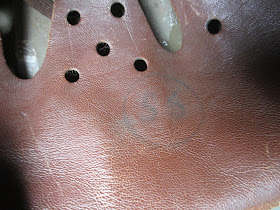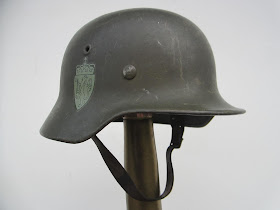This is the first helmet I ever bought.
At some point a person becomes a collector and decides to have two or more of a thing. For some people its little glass figures, for Jay Leno its cars, and for me it was helmets. The interest started when I found a Japanese helmet on the island of Guam in 1972 (video here). The collecting bug remained dormant for ten years. In 1982 I saw an advertisement in some magazine - I think it was for an outfit called the Collector's Armory - they were selling Swedish m.21-18 helmets for something like ten dollars. I don't recall what my motivation was, but I bought one. It was with great anticipation that I waited nearly two weeks for delivery. When it arrived I inspected it, cleaned it with a damp cloth, placed it on a shelf with my Japanese m.30-32, and viola! I had a helmet collection.
At that point in my collecting career I knew next to nothing about helmets except that they were cool, and my actual education in the field didn't start until about my fourth or fifth helmet:
These were the first five that anchored the collection; all but the first acquired in the early 1980s even before I started frequenting militaria shows.
Japanese m.30-32 (found on Guam
The above Swedish m.21-18
Portuguese m.40 (also from a magazine ad)
German m.17 (bought at a gun show)
American m.1917 (a rusted-out relic I found in an overgrown cow pasture)
I was off and running.
All of the above I collected in the early 1980s. About that time I started going an annual militaria show in Lansing Michigan. It was a bonanza of cheap and plentiful helmets. for five or six years I'd go with $450.00 in my pocket and my old Navy seabag. When I came home six hours later I'd have a bag stuffed with helmets and several dollars change.
It was at these shows that my education started. I talked, and mostly listened, to knowledgeable collectors. I was fortunate to make the acquaintance of Floyd Tubbs - the author of the slim volume "Stahlhelm". He sold me a few helmets and gave me a lot of free advice, including this valuable axiom:
"Always buy the best helmet you can afford."
Since then I've always avoided buying junk, fakes (I hope), or "restored" helmets. Floyd started me in a good direction and the last Tubbs helmet I bought was from his estate, several years after he passed away in 2002 at the age of 78. I'm glad, and fortunate to have made his acquaintance.
The Swedish m.21-18 was introduced in 1923 and was used
through the Second World War.
Weighing in at 2.59 lbs it has a deep profile, providing
very good protection for the wearer.
This is a unique design, quite unlike any other of the period or even of later years.
I've had other collectors remark that this is a particularly unattractive helmet but I really like it and its medieval look.
From the rear the helmet is very much bell-shaped with just the hint of a crest.
The three crowns motif is part of the coat of arms of Sweden, and since May 20, 1942 appears as a decal on each side of the helmet.
The handsome plate soldered to the front was part of the original design and has been present on the helmet since 1923. This applied insignia reminds me a great deal of the lion insignia affixed to the front of the dutch m.23-27 .
Like the shell, the liner is particularly robust and obviously influenced by the German m.17 of the Great War.
Three heavy leather leaves with two fingers each,
are gathered together with a leather thong.
The leather is connected to the shell with a metal band, just like the m.17 stahlhelm.
As robust as the rest of the helmet is the two-piece chinstrap,
fastened with a stout brass buckle.
The only marking on this helmet is a not particularly legible ink stamp. Noteworthy is the fact that this particular helmet is missing the edging rim, which often had a production number stamped into the rear.
Beneath each of the three leaves of the liner are fabric pouches
containing cushioning pillows.
Each pillow is filled with coarse horse hair providing a very resilient padding for the wearer. The amount of horsehair could be modified to adjust the fit of the helmet.
It was with this helmet the collection began, and counting that Japanese helmet found on Guam, I've been collecting for over forty years.
I no longer go to militaria shows as I find that ebay provides a superb marketplace for my needs - and those needs are pretty simple. I'm not a high-end collector; my collection is very "garden variety" and as such very seldom do I encounter a dealer who is trying to pass off a fake. One notable exception was an early Soviet Adrian that I acquired last year. Upon examination I determined that it was an obvious fake. Fortunately the dealer, who was a third-party in the transaction (and perhaps blameless) gave me a full refund and I have not subsequently seen it listed on ebay.
This has been a very satisfying and enjoyable hobby and I'm a lucky guy in that my wonderful wife is very supportive of the effort. I look forward to many more years of happily poreing over the details and designs of these signature pieces of the individual foot soldier of many nations.
Cheers!
Mannie




























































